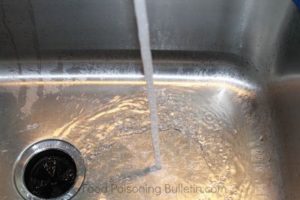Food & Water Watch states that the crisis over Toledo’s compromised water system is only the beginning in the United States. Earlier this month, levels of a toxin called microcystin prompted government officials to tell consumers not to use the water for drinking, cooking, bathing, or teeth brushing. That toxin is produced by a strong algal bloom.
 Over the weekend, the City was increasing monitoring and testing because they said “the testing level of untreated water at the direct intake is showing a strong presence of microcystin.” The water was still considered safe to drink, since the water tested at .972; the World Health Organization has set a limit of 1.0 for that toxin. Chemicals brought the level of the toxin down to .456. Customers may have noticed a film on the water that is not harmful, and more of a chlorine odor.
Over the weekend, the City was increasing monitoring and testing because they said “the testing level of untreated water at the direct intake is showing a strong presence of microcystin.” The water was still considered safe to drink, since the water tested at .972; the World Health Organization has set a limit of 1.0 for that toxin. Chemicals brought the level of the toxin down to .456. Customers may have noticed a film on the water that is not harmful, and more of a chlorine odor.
The algal blooms are caused by phosphorous runoff from excessive fertilizer application on farms, manure from livestock feeding operations, and aging wastewater infrastructure. Other cities have experienced problems took including an outbreak of Pfiesteria, a toxic algae, in the Chesapeake Bay in 1997; contamination in the early 2000s in Tulsa, Oklahoma, and high nitrate levels in Des Moines, Iowa in May 2013.
Runaway fertilizer use, wastewater discharges from polluters and excessive nutrient runoff from factory farms have not been contained because of the strong influence of industry in government. The Clean Water Act has been weakened. And the EPA, instead of enforcing laws against polluters, are allowing water quality trading, letting industry purchase “credits” from other polluters instead of controlling their discharges.
Food & Water Watch states that water quality trading cannot stand as an option since “there is not one documented case of its success.” They also state that runoff from industrial agriculture must be regulated, as mandated by the Clean Water Act. Unless these actions are taken, these problems with our water system will only continue and get worse.




